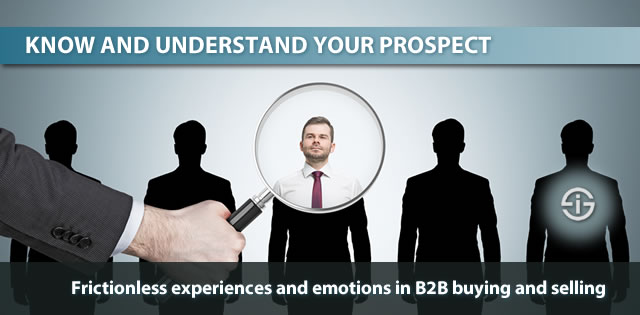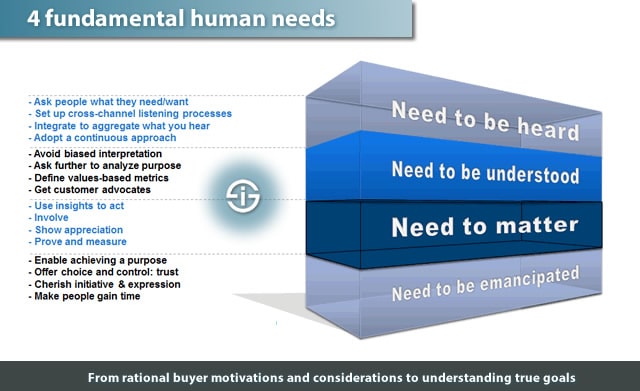How do you solve the buying disconnect in B2B and complex buying journeys? For starters by realizing there is a disconnect and that buying AND selling have both become more complex overall. And by realizing the importance of understanding true – emotional – goals and the prospect experience.
B2B buyers dispose of more means and information to shape their nonlinear and connected journey and buying decisions than ever before. Often they get on the radar of marketing and sales pretty late in these decision processes. Certainly if we, as marketers and sales reps only take a reactive approach. And certainly if we focus all our efforts on lead generation as most marketers still do.
The fact that buyers are more informed and have more means to shape their decisions doesn’t mean that their lives have become easier. On the contrary: for quite a few of them all that choice and information has a paralyzing effect. Smart organizations see that and flip their marketing and sales approaches. To paraphraze the title of the book from Ram Charan we mentioned on this site so many times in the context of value chains, “What the Customer Wants You To Know?”, the question is “What do you REALLY need to know to understand the prospect who wants to be understood?”. Because there is an undeniable mismatch between what we believe prospects want from us and what they actually truly desire and care about.

From rational buyer motivations and considerations to a bond of trust and understanding
We give them products, specifications and solutions which aim to help them optimize or solve whatever we think they need optimized or solved.
Yet, they want far more than that. Their need is a highly emotional one which is partially seen through the signals they give us and the rational motivations which hide their emotional mindset.
It’ striking to see how we understand the importance of customer experience, employee experience, patient experience, citizen experience and ‘fill in the blank’ experience as being de facto highly emotional realities, yet seem to overlook it when it boils down to ‘prospect experience’ and ‘salespeople experience’ (a topic for another article).
If a prospect is paralyzed, as mentioned, that is a serious emotional thing to consider. When prospects set out to buy a solution or we reach out because we would like them to consider a solution, that is consequence/part of an emotionally complex given. Our mindset, as sellers, is not the same of that of prospects, the buyers. And it’s in understanding the prospect’s mindset and real goals and stakes at hand that we can forge the most important emotional aspect of all: a bond of trust, attention and true understanding, one of “feeling the customer“.
Understanding the reality behind tasks and buyer goals should shape sales enablement initiatives
Sure, at several given points prospects will look at technical specifications, opinions and benefits your existing customers have/realized and a bunch of other practical and seemingly rational criteria. From a sales enablement perspective you need that too.
Yet, when push comes to shovel we are indeed talking emotions, mindsets and goals beyond what we perceive as goals. Understanding these ‘real’ goals and mindsets is what makes salespeople succeed. It drives the kind of information they need in order to become a trusted advisor and it certainly drivers their needs regarding sales enablement content.
Too many marketers still haven’t understood this, despite the fact that it’s nothing new; it’s just more essential than ever. As an example: do you know the ‘customer carewords’ methodology and approach of Gerry McGovern? If not, you can read more about it here. We’ll come back to it in instance.
Customers have a task and it’s the task that matters. In important buying decisions tasks are part of an emotional reality of prospects.
“I need to digitally transform the company my parents built 50 years ago and I successfully run at an international scale since over a decade but now is under increasing pressure” becomes “I am scared my company goes bankrupt as margins are eroding, competition has increased and I missed the digital boat while others haven’t”.
This is an entirely different mindset than the practical consequences such as “I need to automate this and that” or “I need to adapt my business model and tap into the opportunities of abc, for which, among others I’ll need solutions def and xyz”. We can take it even further to far more emotional and unconscious levels. “What happens if my company goes bankrupt?”. “People will call me a loser and abandon me”. “My dad/partner/kids/whomever will hate me”. “I will disintegrate as this company is the work of my life and family; in fact it’s me”. “My employees will feel the same, their children will starve”. You can go on.
Care and knowing what you need to know
Obviously, if you’re a seller of a solution that can help overcome those eroding margins or tap into those new benefits you won’t tell a prospect that you have a solution to make sure his/her dad will not hate them.
But you sure want to know what’s really at stake and what all those numerous other emotional concerns along the way are (“How do I know I can trust this company?”, “What if I make the wrong choice?”, “Is this really the best way to solve my company’s problems or should I look at it differently?”).
Coming back to Gerry McGovern‘s ‘customer carewords’, which are mainly used in a website content context, this is where carewords come in. “How do I know I picked the right university for a prosperous career as xyz?”. Well, carewords on the university’s website aim to exactly convince students emotionally by doing that: understanding what students REALLY care about, not what we, as sellers, care about.
Of course there is a difference between a student looking on a website of a university and seeking reassurance and the CEO of a company who is about to invest in solutions to automate and overhaul a bunch of processes to make his business survive and thrive, regardless of medium or source. But then again, is there really?

We all know that customers want frictionless experiences. We know that users of our platforms or apps, whether they are external customers or employees, want frictionless experiences. And we do know the need for speed, for simplicity and for emotional gratification, reassurance and all those essential human needs.
Yet, we also have to understand what our prospects truly care about and how they experience that buying journey, that decision-making progress, the real concerns, the information that paralyzes them, the emotional realities behind their goals (to the extent of the possible) and, at least as important, us and how we, as companies and salespeople facilitate their journey and make it more frictionless and real.
Smart sales leaders realize this and focus on true goals, bonds of trust, sales enablement that shows deep customer understanding and the removal of that emotional garbage, which friction in the end causes and is all about, also for prospects.
Top image: Shutterstock – Copyright: ImageFlow – All other images are the property of their respective mentioned owners.

